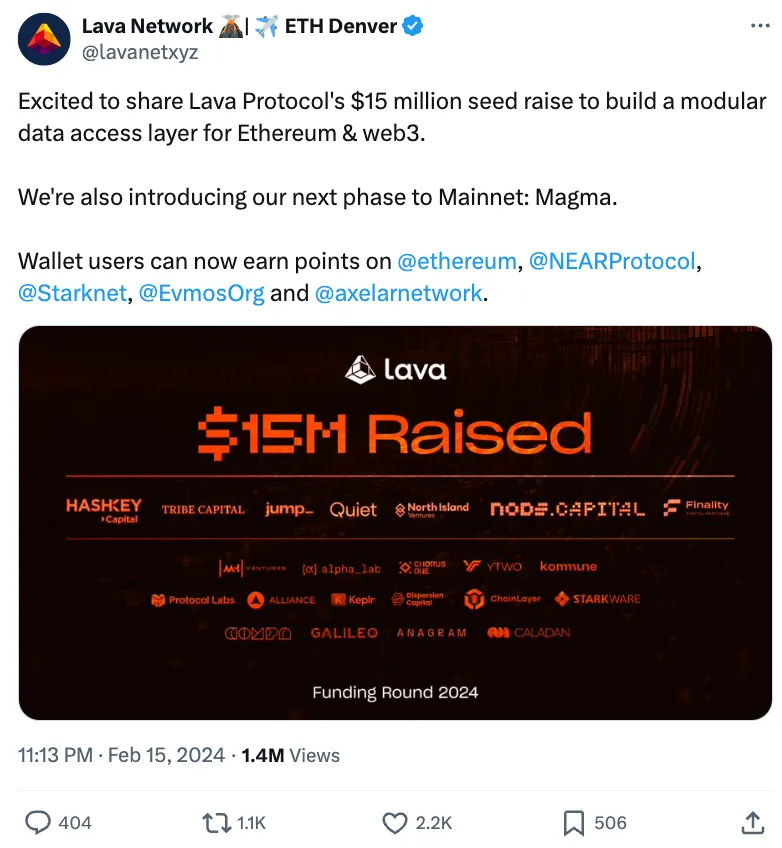Lava Network serves as a dynamic P2P market, connecting blockchain and dApp with node providers that offer RPC services and data.
Authored by: Revelo Intel
Translated by: DeepTechFlow
Introduction
As the price of $BTC approaches its all-time high, and hopefully other altcoins follow suit, people are easily drawn to the price. However, people should not forget the underlying technology and infrastructure that make all of this possible. As new user-oriented applications continue to emerge, infrastructure projects are also continuing to raise funds and implement, similar to the previous cycle.
This article focuses on Lava Network, which acts as a dynamic P2P market, connecting blockchain and dApp with node providers that offer RPC services and data. With the recent funding, upcoming mainnet, and point system, this modular data layer is becoming increasingly popular.

Lava Network
Lava Network is a modular data network that provides developers with scalable access to any rollup or blockchain. Recently, the term "modular" has been frequently mentioned, but what does it mean? In the context of Lava, it allows any blockchain to access its data network to help with scalability. Lava is a network of node providers that offer access to data and RPC. It essentially helps make these things more accessible to various blockchains.
The demand for this service has been proven, as blockchains have chosen data availability (DA) solutions such as EigenDA and Celestia. Lava Network eliminates intermediaries, allowing blockchains to gain features such as censorship resistance, transparency, and privacy. Using a node network rather than relying on a single node or using multiple node providers may be more favorable.
Yair Cleper, co-founder of Lava Network, uses Amazon's business model as a metaphor to explain the role of Lava Network.
Peer-to-peer SDK: Allows dApps to communicate directly with multiple providers without intermediaries. Providers are rewarded for their services based on evaluations. In this case, dApps are the customers, and P2P providers act as Amazon merchants. After the transaction settlement, providers are rewarded for their contributions. There are already over 300 providers on the Lava Network.
Specs: "Champions" in Lava can define RPC APIs based on specific chains. They provide these specifications to the community, and node providers can launch nodes based on these specifications. The specifications can be seen as products provided by Amazon itself. Champions are those who provide the specifications and also define the RPC for specific and upcoming chains.
Just as Amazon has many suppliers, trust is distributed among multiple providers, ensuring the scalability and reliability of the Lava Network. Lava aims to be a one-stop platform for accessing blockchain data. It eliminates the need for developers to individually obtain RPC providers and index data on their own. Lava allows for the quick addition of new chains and APIs based on demand.
Lava Network's Origins
Lava Network was co-founded by Yair Cleper and Gil Binder, who come from Israel and have experience in building multiple startups in the Web2 field. Initially, they wanted to build a multi-chain NFT marketplace but realized that running their own nodes for each blockchain was resource-intensive. They then explored using node providers but found limited options for certain chains, such as Cosmos. Existing providers were either limited or not reliable enough to meet their needs. They decided to focus on Ethereum first, but once again faced API limitations and the challenge of using multiple providers.
Ultimately, the team realized that the blockchain world is fragmented, complex, and slow in terms of accessing data. This is the area that Lava Network hopes to intervene in. Lava Network aims to simplify the multi-chain landscape by providing a one-stop solution for accessing blockchain data. With Lava Network, developers can easily access relevant providers without needing to know which provider is being used behind the scenes. The design of Lava Network is modular and flexible, making it easy to integrate new chains as they become popular.
Recent Funding for Lava Network

While the amount of funding alone cannot definitively indicate the future success of a project, it does indicate that investors see potential in the product being offered. It is worth noting that Lava Network recently completed a $15 million seed round. Jump Capital led the seed round, with participation from Hashkey Capital, Tribe Capital, Alliance, Node, North Island, Quiet, Finality, and Dispersion Capital.
Blockdaemon, which previously invested in Alchemy, ConsenSys (Infura), and QuickNode also participated in this round of funding. Validators, ecosystems, and founders from Cosmos, Polkadot, Filecoin, StarkWare, Axelar, NEAR, Celestia, Celo, and others also joined this round of funding.
Lava Network is evidently closely integrated with the Cosmos community. Dozens of providers from different ecosystems have already joined Lava and receive rewards at the end of each month.
The mainnet for Lava Network is planned to launch in 2024. Currently, the protocol is focused on expanding its product supply to non-technical users. While the product concept may initially be difficult to understand, the team is building communities of non-technical users in Korea, Turkey, Africa, and other places. These communities are essential in providing assistance for the mainnet release in terms of writing guides and documentation.
Lava will soon introduce a point system to attract non-technical users to participate. This system aims to allow each user to provide accessible services while maintaining a public interest, bringing real value to Web3.
免责声明:本文章仅代表作者个人观点,不代表本平台的立场和观点。本文章仅供信息分享,不构成对任何人的任何投资建议。用户与作者之间的任何争议,与本平台无关。如网页中刊载的文章或图片涉及侵权,请提供相关的权利证明和身份证明发送邮件到support@aicoin.com,本平台相关工作人员将会进行核查。




